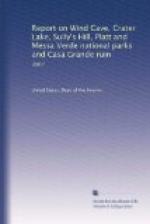Dimensions.
It is probable that the area immediately adjacent to the ruin, and now covered by mounds, carried buildings of the same time with the main structure and was occupied contemporaneously with it or nearly so. This area, well marked on the map, measures about 400 feet north and south, and 240 feet east and west. It is not rectangular, although the eastern and western sides, now marked by long ridges, are roughly parallel. The northeastern corner does not conform to a rectangular plan, and the southern side is not more than half closed by the low ridge which extends partly across it. This area is doubtless the one measured in 1776, by Padre Font, whose description, was copied by later writers, and whose measurements were applied by Humboldt and others to the ruin itself. Font gave his measurements as those of a circumscribing wall, and his inference has been adopted by many, in fact most, later writers. A circumscribing wall is an anomalous feature, in the experience of the writer, and a close inspection of the general map will show that Font’s inference is hardly justified by the condition of the remains today. It seems more likely that the area in question was covered by groups of buildings and rows of rooms, connected by open courts, and forming an outline sometimes regular for a considerable distance, but more often irregular, after the manner of pueblo structures today. The long north and south ridge which forms the southeastern corner of the area, with other ridges extending westward, is quite wide on top, wide enough to accommodate a single row of rooms of the same width as those of the ruin, and it is hardly reasonable to suppose that a wall would be built 10 or 12 feet wide when one of 4 feet would serve every purpose to which it could possibly be put. Furthermore, the supposition of an inclosing wall does not leave any reasonable explanation of the transverse ridges above mentioned, nor of the long ridge which runs southward from the southeastern corner of the ruin.
The exterior walls rise to a height of from 20 to 25 feet above the ground. This height accommodated two stories, but the top of the wall is now 1 to 2 feet higher than the roof level of the second story. The middle room or space was built up three stories high and the walls are now 28 to 30 feet above the ground level. The tops of the walls, while rough and much eroded, are approximately level. The exterior surface of the walls is rough, as shown in the illustrations, but the interior walls of the rooms are finished with a remarkable degree of smoothness, so much so as to attract the attention of everyone who has visited the ruin. Mange, who saw the ruin with Padre Font in 1697, says the walls shine like Puebla pottery, and they still retain this finish wherever the surface has not cracked off. This fine finish is shown in a number of illustrations herewith. The walls are not of even thickness. At the ground level the exterior wall is from 31/2




